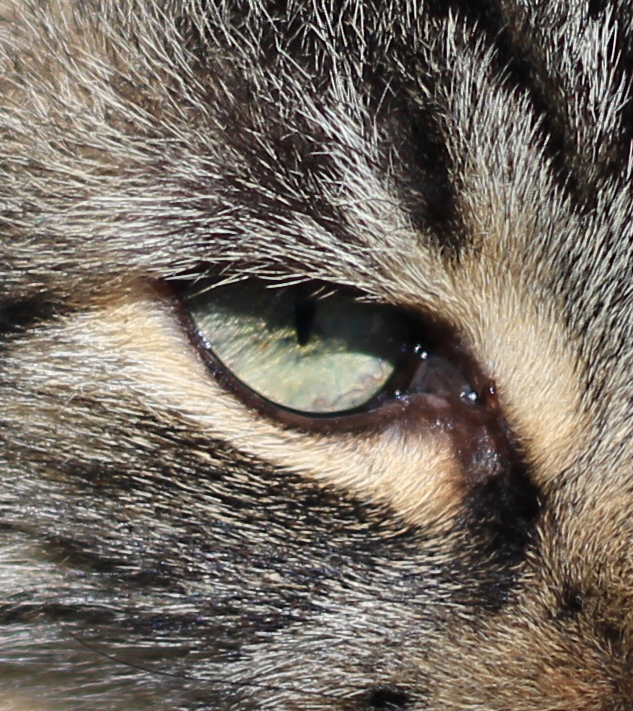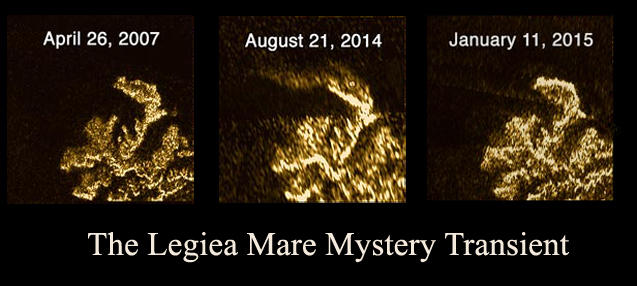Does the Loch Ness Monster have a brother on Titan? The Ligeia Mare Mystery surfaces, then disappears
posted Sunday, March 13, 2016 at 8:17 AM EDT

Wake up with IR! Here's today's dose of Caffeine Priority...
Thanks to modern imaging technology and space-faring crafts like Cassini, we're getting a whole new perspective on our own backyard these days, the wonderfully mysterious Solar System. Infinitely more interesting and perplexing than we imagined just a few decades ago, it's the images being beamed back to us that are thus far telling the biggest tales.
And what a tale we're getting from a lake on the Saturnian moon Titan!
Throughout human history it's been common for us mere mortals to speculate on the supernatural possibilities of unexplainable events and phenomena before allowing pure science to determine what natural forces are actually responsible for the unexplained. And why not... it's fun! Any armchair scientist with a keyboard and an internet connection can join into the speculative fray and be heard by the multitudes, and perhaps more than once has one even contributed to the scientific path of discovery.
So when I learned via APOD that NASA had potentially discovered a modern day sea monster, well, I felt compelled to share it with our enthusiast imaging readership for anyone who's yet to get their first glimpse. Yes, it's only tangentially related to what most of us do with cameras, but I'm sure you won't begrudge me the latitude for sharing it here on IR. I mean, in these days of a billion new images being uploaded online on a daily basis, this one is certainly worth more than just a casual glance!
The Evolution of a Transient Feature

estimated to be a full 1.5 times the size of Lake Superior here on Earth.
The highlighted area is a landmass now commonly known as Magic Island.
(Image credit: NASA/ESA/Cassini)
We already knew that the beast of Ligeia Mare had surfaced several years ago on the northernmost peninsula of Magic Island, but it was only last week that a more recent image of the area was released to the armchair scientist crowd, myself among them, showing that it had clearly resubmerged to the cold hydrogenic depths of Ligiea Mare.
Here, and then, gone.

What the Cassini Team is saying
From Nasa's Jet Propulsion Laboratory at Cal Tech: "The team has suggested the feature could be surface waves, rising bubbles, floating solids, solids suspended just below the surface, or perhaps something more exotic."
"Science loves a mystery, and with this enigmatic feature, we have a thrilling example of ongoing change on Titan," said Stephen Wall, the deputy team lead of Cassini's radar team, based at NASA's Jet Propulsion Laboratory in Pasadena, California. "We're hopeful that we'll be able to continue watching the changes unfold and gain insights about what's going on in that alien sea."
Now, that "alien sea" is merely the second largest lake on Titan, but what's so interesting it that it's very likely connected to the largest lake, dubbed Kraken Mare. If you're raising an eyebrow as I did, all the better, because most of you will recall the mysterious sea beast from lore known as The Kraken, a giant squid said to dwell off the coast of Norway and Greenland.

Pure Science fans now hear this: The Kraken was once given an actual scientific name!
Microcosmus marinus, "a unique monster" of the seas of Norway, as classified by Carolus Linnaeus. The Kraken's legend grew thereafter, and was mentioned in the famous works Moby Dick, by Herman Melville in 1851, and in Twenty Thousand Leagues Under the Sea by Jules Verne in 1870.
(Image is in the public domain; Classification reference seen via Wikipedia)
The Mythical Beasts of the Sea
I just realized... The legend of The Loch Ness Monster and stories about The Kraken held great interest for me as a kid, and here I am writing about a third mysterious potential sibling found on Titan so may years later. Is there a similairty? Well, other than the obvious mystery of the unexplainable, the similarity for me is the mysterious locale in which they were all "spotted".
The cold depths of a Scottish Loch, the lore-entrenched shores of Norway, and now a primordial lake on a mysterious, cloud-enshrouded moon. These places on the edge of the etherial provide ample fodder for the imagination in all of us, young and old. It doesn't really matter if these apparitions are living beings or not, only that there's the slightest chance that they could be, in order to stoke the curiosity fires in most of us.

This iconic image is known as the "Surgeon's Photograph" because the man who reportedly
captured the image, Robert Kenneth Wilson, apparently didn't wish to be associated with it.
(Image via Creative Commons; Description from Wikipedia)
And, for anyone wondering what "Ligeia" means, that is really most interesting as well. As reported by the Ligeia Mare wikipedia page, Ligeia is one of the sirens in Greek mythology. However, searching for "Ligeia" reveals that the name was also used by Edgar Allan Poe as a short story describing a beautiful woman named Ligeia who falls ill and then composes a poem titled "The Conqueror Worm"..... very interesting.
Diving into the heart of the matter
Onto the future and for all fans of the possible: If the proposed "Titan Saturn System Mission" is indeed launched, the end result of that mission will most likely be... you guessed it: A splash-down into Ligeia Mare! This will potentially include the first extra-terrestrial robotic submarine, dubbed the Titan Mare Explorer (TiME). There's also yet another Titanic mare exploration program being considered dubbed TALISE (Titan Lake In-situ Propelled Explorer), a proposed Spanish space probe to head to Ligeia Mare and get up close and personal with the methanic surroundings.
So, we may someday plunge a rover sub into a sea of liquid hydrogen. I simply can't help but conjure up images of the alien from the original movie Alien, whose physiology was based on acids and silicone. Alien is a fantastic exploration of what finding life on other planets might actually be like, as compared to the typical fantasized sci-fi cliché.
That film had us finding life on a planet far from our own solar system, but what if, after all of our speculation, there really is life on a moon like Titan? Not necessarily this phenomenon of course, which is more likely an interesting wave or random scattered matter, but life that evolved from a gas such as methane? Wouldn't it be just as intriguing, and potentially life-threatening, as the alien in Alien which bled acid for blood? After all, we've now discovered life in places on earth we once believed inhospitable to life as we know it.

Life After Nessie
Of course, moving beyond the alien speculation and the monster myths, it is still very intriguing to be viewing shifting lakes on another world. Hydrocarbon though they may be, these are still fluid, ever-changing bodies we are observing, just like the gaseous motion of Jupiter's well-known Great Red Spot that we've studied now for over a century. Movement implies evolution, currently in the works for us to investigate, and as interesting as our own moon surely is, bodies like Titan are simply far more tantalizing in their possibilities for amazing us with their mystery.
So, we'll keep honing our scientific instruments and imagers, and who knows, perhaps one day we'll actually uncover something that's not later found to be waves or silt or sand being blown around... perhaps.
• • •
Simlar content on our site:
Are these trees on Mars?
How about you? Have any speculations to share with our readers on what this observed phenomenon might potentially be? Sound off in the comments below and Ye Shall Be Heard!


[Need another shot? ...Try our Espresso!]
Caffeine Priority is a new series of short photo-tidbits to ease you into your day, and give us a chance to share a bit more of what life’s like here at IR. We're more like a group of friends testing and talking about cameras and lenses than the buttoned-down, big-corporation world that some of our photo-friends at other companies work in; hopefully these little snippets will share some of that. So... grab another coffee and join in the conversation with us down below!








